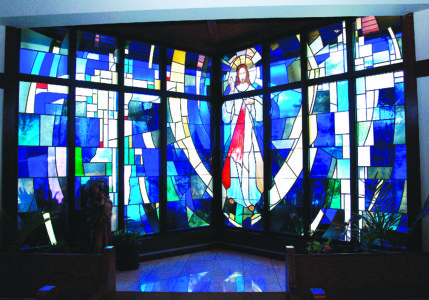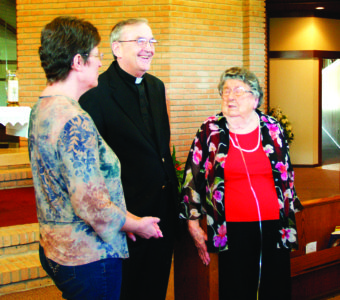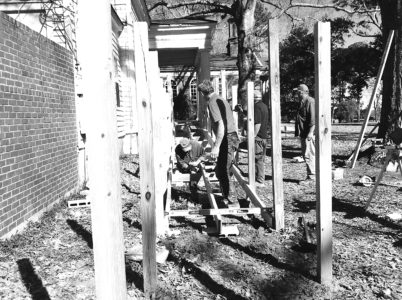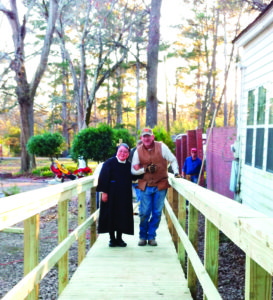
CLINTON –above, an image of Jesus, familiar as the Divine Mercy image, is visible in the new window at Holy Savior Parish. (Photos by Maureen Smith)
By Maureen Smith
CLINTON – The Callegan family of Holy Savior decided they wanted to leave a family legacy to their parish, but after Ivy Callegan put instructions in her will to direct part of her inheritence to her parish, she changed her mind. “A while back I started thinking, I don’t have to wait until I’m gone, so I called Father (Thomas McGing).” Callegan told him she wanted to give the money now and asked Father McGing how he thought it could be best used.
The result is a window incorporating the Divine Mercy image of Christ flanked by two crosses. The crosses are not obvious at first, but come into focus when the viewer spends some time in front of the image.
“The passion cross has the five wounds of Christ in red. The cross of the Easter resurrection has Easter colors, pastels and whites,” explained Andy Young, the artist from Pearl River Glass studio who designed the

At left, Julie Harkins, parish secretary, Father Thomas McGing, pastor, and Ivy Callegan, founding member and donor, talk about the new window.
window. He also created the windows in the sanctuary of the church back in 1988. He said the mix of abstract and specific imagery is deliberate. He wants people to be able to interpret different things from the windows.
Callegan said she is delighted with the result. She came to check on the progress of the work one day, not knowing that the project was more than half-way done. “When I hit the door to the sanctuary, I looked up and I just sort of froze. I guess the Lord was with me to tell me to do this window,” she said.
Young said the parish gave him an image of Divine Mercy as his inspiration. Father McGing said it seemed like the perfect place to start.
“We wanted to highlight the name of the parish – Our Savior – and we started talking about it during the Year of Mercy and the more we talked about it the more we wanted to highlight Our Savior, who is the source of mercy and whose heart bleeds with love and mercy for us,” said the pastor.
The window is made up of several panels which sit at a 90-degree angle in the chapel behind the main altar. The chapel is used for daily Mass, but is visible from the sanctuary.
“If you look from the right spot inside the sanctuary, the lines of light radiating from Jesus line up just right behind the tabernacle,” said Young. “I had not intention of doing that whatsoever, but it was such a nice serendipity- it was a blessing,” he added.
Callegan surprised her family – only showing them the window after it was installed. “The best reaction I got was when Catherine, my 9-year-old granddaughter, came through the door there, and said ‘oh mamaw, it’s amazing,’ I don’t know how many ‘a’s there were in there! I’m really close to those kids, she and her brother, who is 12,” she said.
Callagan and her husband were founding members of Holy Savior. She said his years of hard work in the oil industry made the Callegan family donation possible.

 JACKSON – Bishop Joseph Kopacz presented 21 adults and five young people with the Bishop Chanche Award for service during a Mass on Saturday, February 18, in the Cathedral of St. Peter the Apostle. The award was established during the celebration of the 175th anniversary of the Diocese of Jackson back in 2012.
JACKSON – Bishop Joseph Kopacz presented 21 adults and five young people with the Bishop Chanche Award for service during a Mass on Saturday, February 18, in the Cathedral of St. Peter the Apostle. The award was established during the celebration of the 175th anniversary of the Diocese of Jackson back in 2012.
 ure washed the sidewalks.
ure washed the sidewalks.